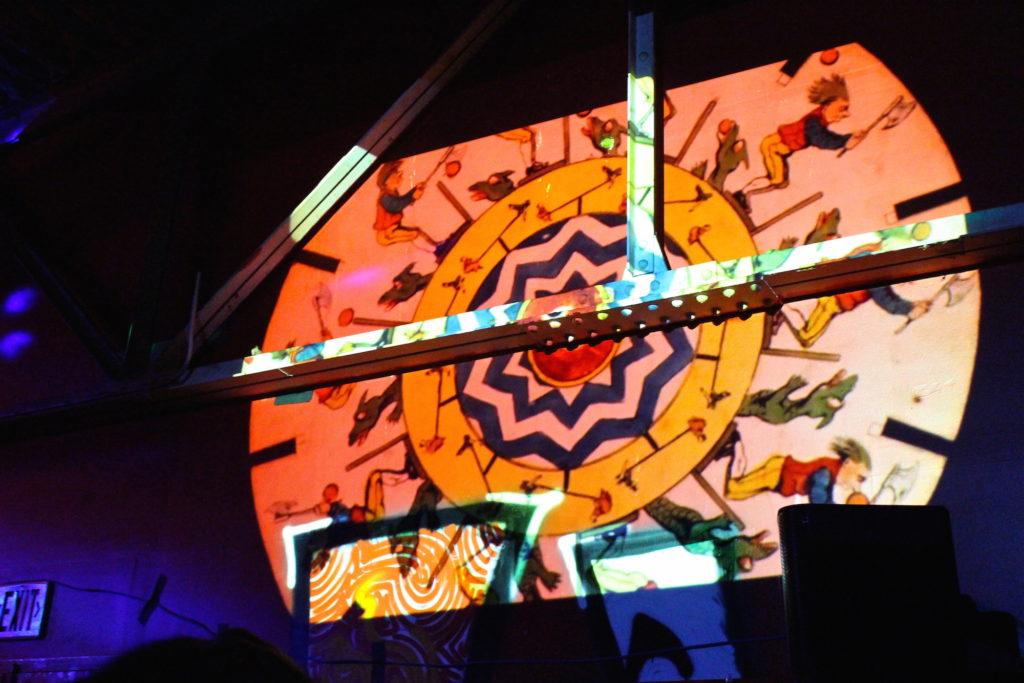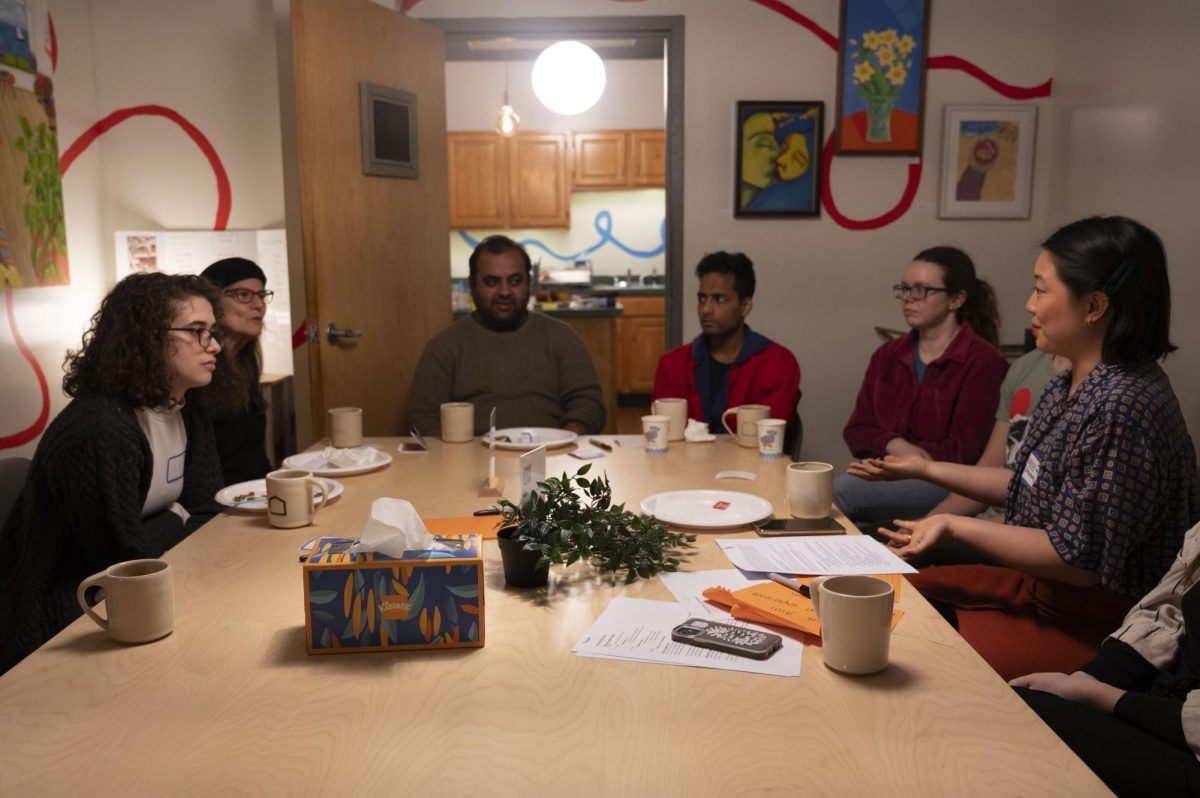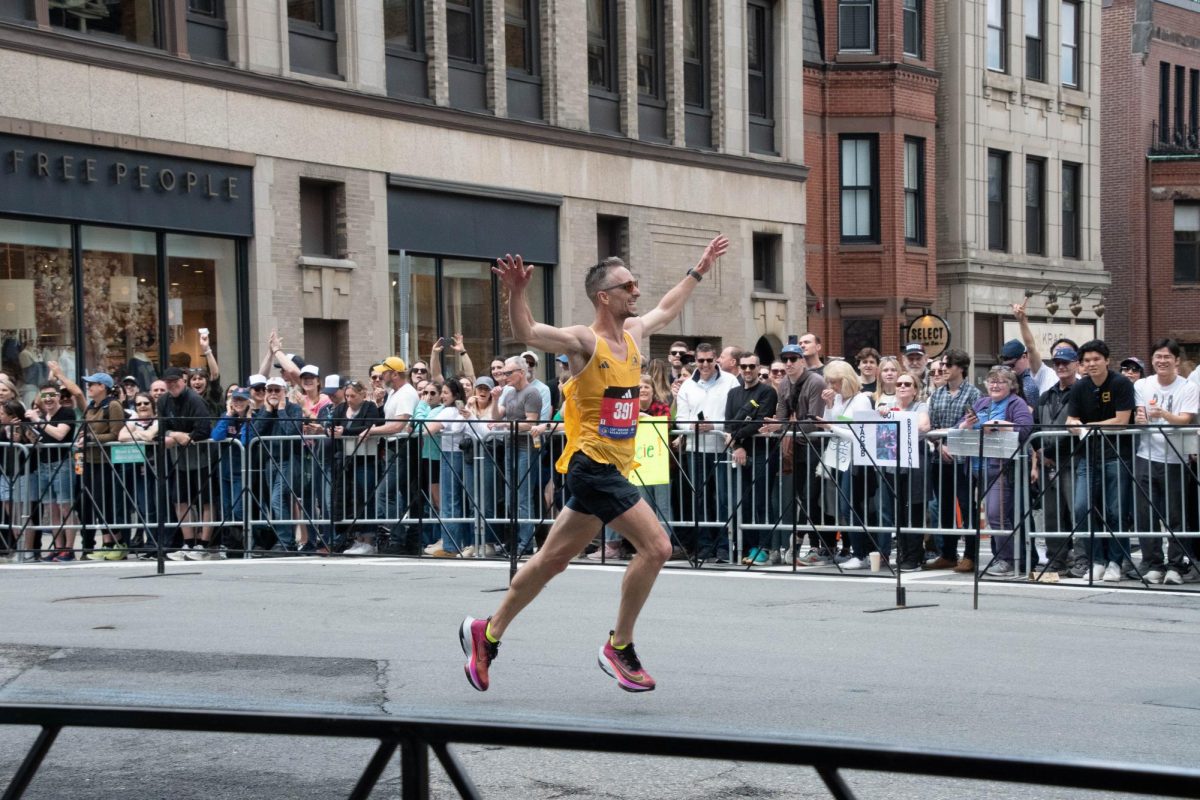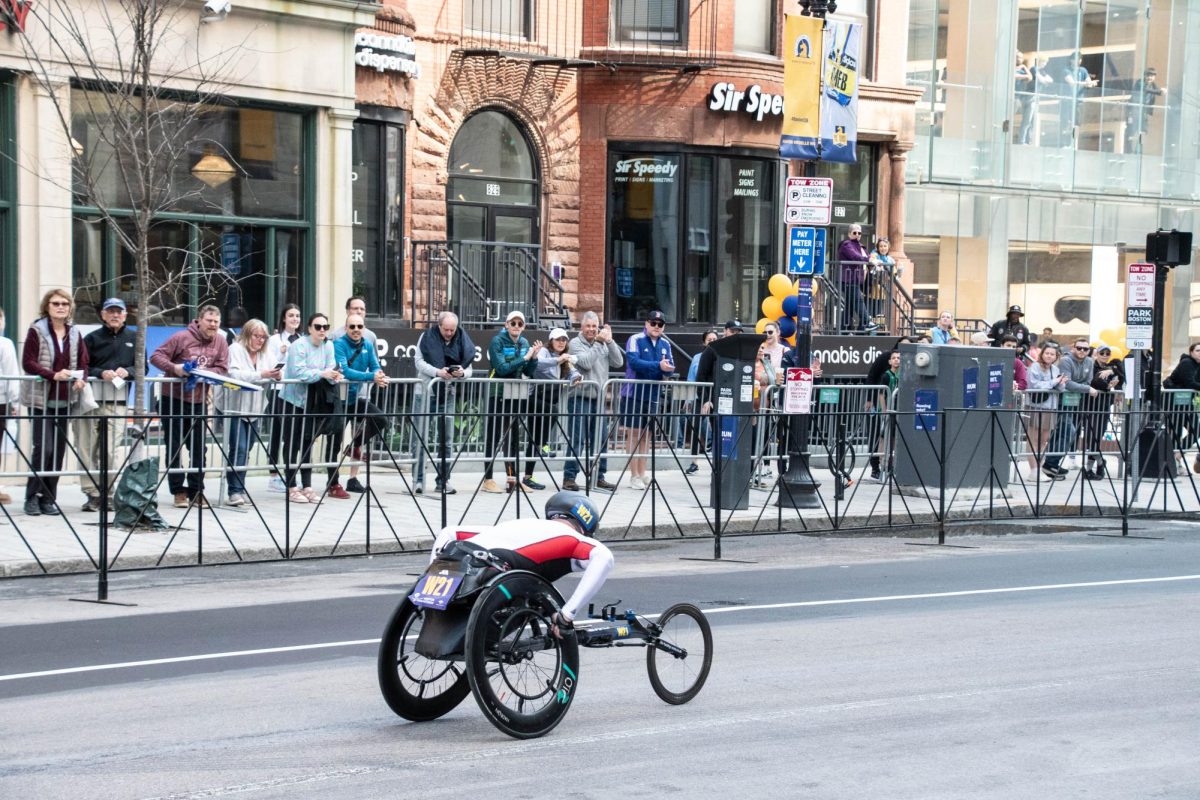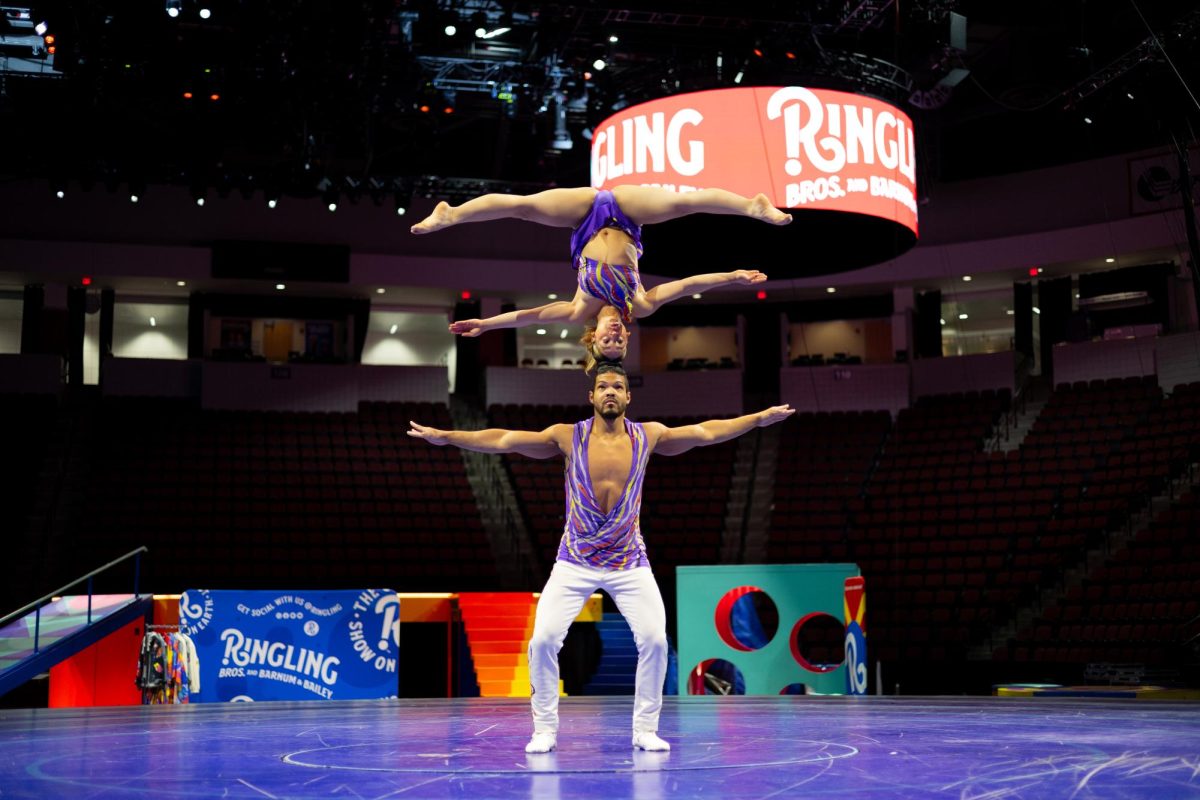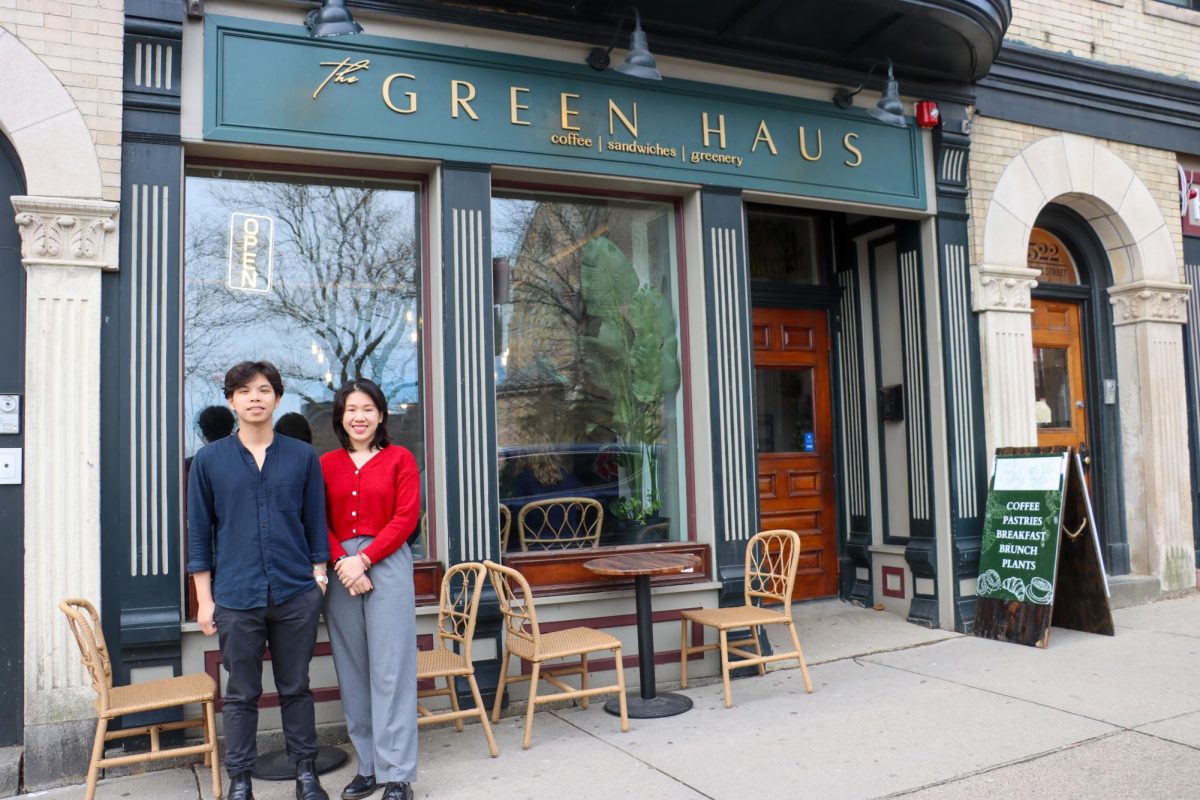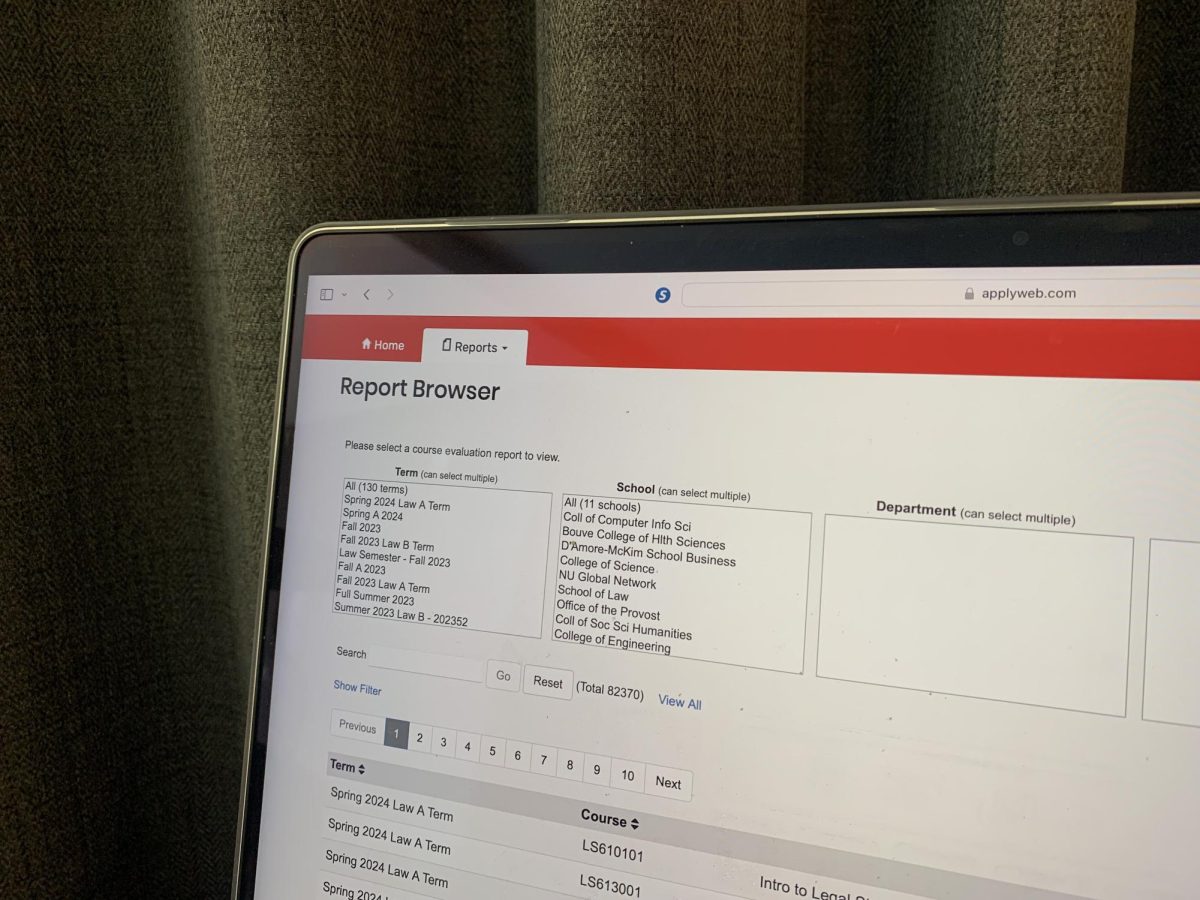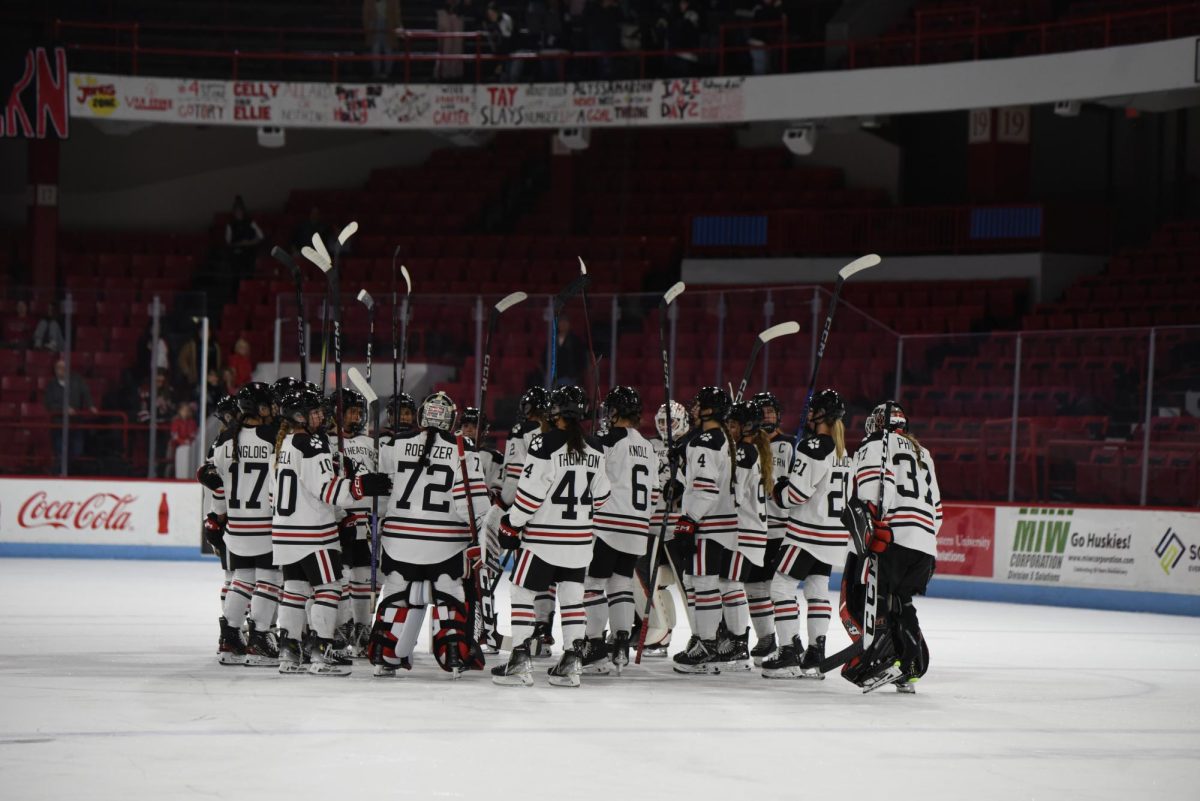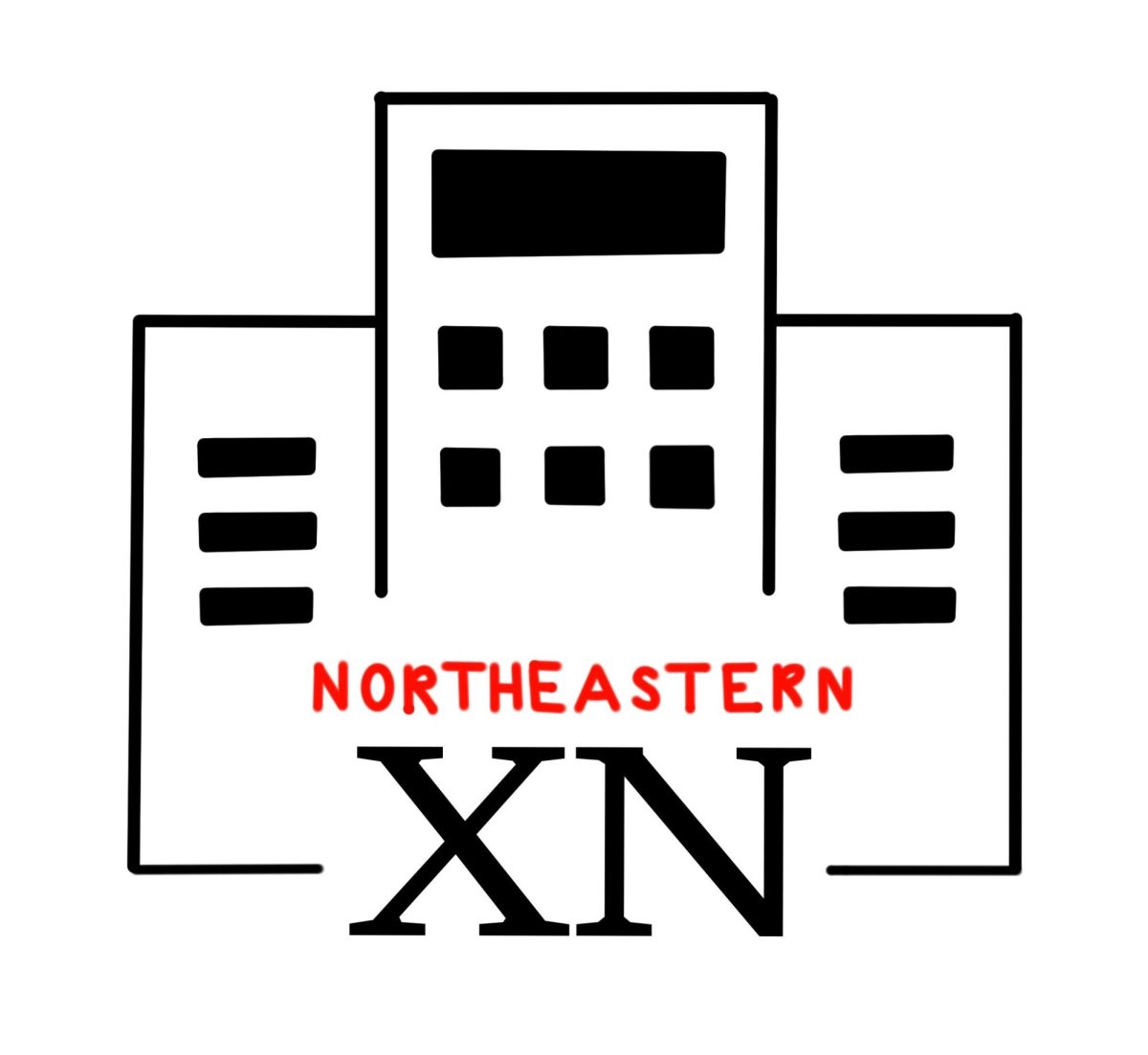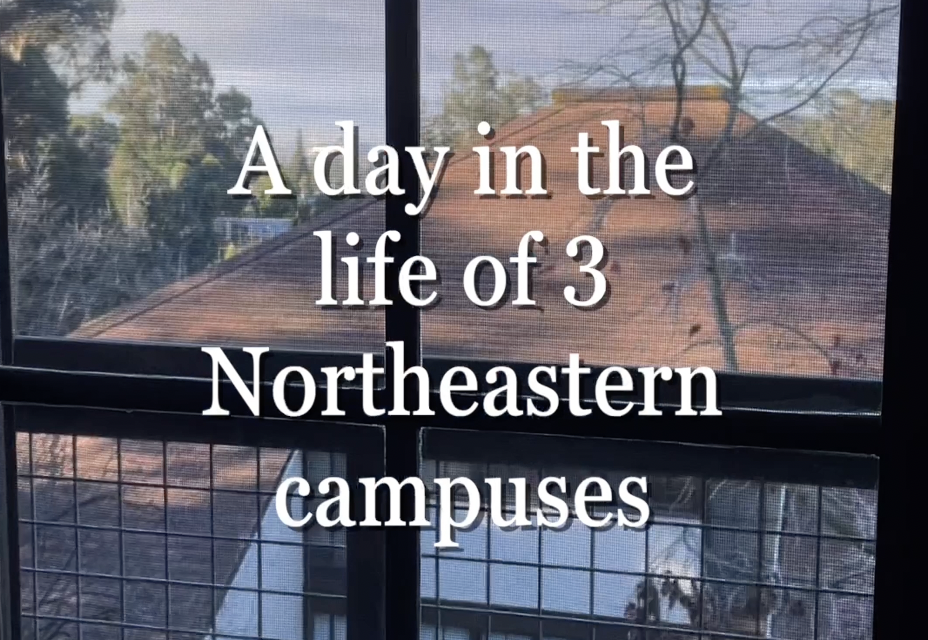By Catherine Lindsay, news correspondent
“Stay close to the building and keep it down. If you’re not smoking, go back inside.”
Sean Hart, 38, from Boston, pronounces this rehearsed line as he ushers people through a nondescript metal door. At first glance, the building looks like any other structure in this industrial Somerville neighborhood. It’s a T-shirt silk screening factory, but it also houses bi-monthly dance parties with international disk jockeys (DJs).
The faint sound of bass resonates through a corridor leading up to a closed door. Opening it lets out a sweaty heat and the full effect of Sanna La Fleur Engdahl’s music, a Swedish-born, Berlin-based DJ who was flown in from Berlin at the expense of the organizers. Strobe lights criss-cross the small studio room at capacity with dancing people who have paid their $20 cover charge. A couch at the front of the room overflows with jackets and coats. Graffiti covers the walls of the closed-off improvised dance floor. The crowd is packed tightly, but there are no fights, no people passing out and not too many public displays of affection.
Dancers move and sway in unison to the rhythm of the loud techno music, throw their heads back and occasionally close their eyes. Near the DJ table, Patrick Black, the 31-year-old Bostonian founder of Dusk Till Done, the organization responsible for the event, watches over the crowd, taking the occasional swig from a bottle of Rubinoff vodka.
“We don’t have a bar because it’s too expensive and risky,” he said. “The events are BYOB [bring your own booze]. It’s much easier that way.”
At around 3 a.m., the music suddenly cuts out, and groans travel through the crowd. After a few minutes of hushed conversations, giggles and resounding “shushes,” Adam Bisbee, 39, from Boston, walks in and stands on top of the couch, announcing that police officers are shutting down the party.
He apologizes, adding, “Most of you here have been to our events before. You understand that this is always a risk. There will be other ones and we will continue, but not tonight.”
And just like that, it’s over. The crowd exits one by one onto the street and disperses.
“Of course, this is always a risk,” said John Maci, 34, from Boston. “But we aren’t technically doing anything illegal, and it’s a necessity. Boston is a small city, and we need more parties like this.”
*****

Black founded Dusk Till Done in September 2013 with the goal of offering something different from the “popularity contest” of Boston’s nightclubs. He wanted to create an environment of community and trust with a focus on music and dancing, “not getting wrecked.”
At a time when mainstream clubs in the Boston area close early, cost more than some are willing to spend and lack range in terms of music genres, organizations have formed that create events tailored to those who want a different experience.
Enter Community Links and Dusk Till Done, two such groups. Through Facebook, they inform their followers of what and when, but never where. The addresses where the events take place are only given the day of, and only by messaging the organizers.
Reminiscent of the 1990s Boston rave scene, these events put local and international DJs in the spotlight and emphasize the importance of music and respect, rebelling against the popular electronic dance music (EDM) scene. Now Boston, along with music-centric East Coast cities New York and Montreal, is experiencing a resurgence of warehouse parties, where the early days of techno and house music once reigned.
Whether the events are BYOB or have a bar, the organizers run the risk of getting into trouble with law enforcement for unlicensed event-throwing, which is why this underground community is tight-knit and secretive. Their attendees are mostly in their late 20s to early 30s, reflecting a shift in interest from the early ‘90s raves, populated with people aged 15 to 25, according to the Canadian Medical Association’s review of the rave scene.
The principles promoted by these new organizations focus on inclusiveness and absence of judgment, in response to popular clubs that are selective and expensive. Quality of music is paramount to those involved in the dance scene.
“They all feel included, they all belong,” said Polina Starobinets, the 33-year-old director of marketing and communications at MMMMaven, an electronic music production school in Boston. “It’s really a community centered around their love of music.”
Andrew Mall, assistant professor of music at Northeastern University, compares the resurgence of these types of events to underground disco and dance music of the ‘70s and ‘90s.
He adds that public perception and the media are very important in determining these cycles of popularity and distancing from negative attention.
“It is a reaction against the slick electronic dance music scene,” Mall said. “As the festivals get more attention, they attract people who don’t understand the values of that scene. People want a return to music.”
This revival of the rave is accompanied by a detachment from rave culture.
“Today’s scene moves away from the debauchery and hedonism of the ‘90s,” said Wayne Marshall, assistant professor of music history at Berklee College of Music in Boston. “Instead of being alcohol or drug-focused, these events are all about the music.”
The appearance of these events seems to answer a demand for different music genres both in Boston and around the United States. Shuja Haider, a 28-year-old music journalist from New York, says that this type of underground event always occurs when a specific style of music isn’t played at legitimate events.
“The problem is less a lack of interest on the part of the public than a reluctance from venues to try something new,” he said. “The city is always fighting back.”
*****

In the United States, two parallel movements created the ‘90s rave scene and culture that we know of today.
In the late ‘80s, acid house – a subgenre of EDM – parties began to take place in Chicago, and they experienced success overseas. These parties spread to the United Kingdom in warehouses and clubs. However, farther east, a different movement was beginning.
“Frankie Bones was one of the founders of the New York and US techno scenes,” said Sara Simms, a 24-year-old producer, DJ and journalist from Toronto. “He created a series of raves in NYC called Storm Raves.”
Bones was an American house music DJ from New York who was known for bringing rave culture to the United States after playing at a hangar party in the United Kingdom in 1989. These two movements, and possibly others across the country, contributed to the creation of rave culture.
The Canadian Medical Association’s review of the rave scene defines raves as “all-night dance parties attended by large numbers of youth.”
It identifies four key components of rave culture: Underground or noncommercial electronic music, liberal use of drugs, clandestine venues and people aged 15 to 25 from middle-class backgrounds.
“People got hooked on a beautiful all-night experience like no other,” said Simms. “It was an escape from society to an immersive event.”
She added that a very important part of the culture was the PLUR movement: Peace, Love, Unity and Respect. Frankie Bones is credited with creating this ideology when he yelled, “If you don’t start showing some peace, love and unity, I’ll break your faces” in response to a fight breaking out at one of his Storm Raves.
“PLUR has been a part of the dance scene for a long time,” said Wayne Marshall. “This hedonistic view was central to the success of raves.”
Drugs were also very present at this time: Ecstasy – a club drug associated with all-night raves and parties – experienced an upswing among teenagers and young adults. According to Gallup, an analytics company, federal funding for the war on drugs reached $17.1 billion in the ‘90s.
This environment of mutual toleration, sharing and inclusivity allowed freedom of dance, sexual expression and drug use, values espoused by participants in the scene.
“It was fulfilling as a community experience,” said Marshall. “Many of the mainstream nightclubs playing this music were exclusionary and only welcomed a few kinds of people based on age, dress, looks and finances.”
He believed this is what led DJs to take their music to abandoned warehouses, old churches and other evacuated areas. Haider said this was the case in Boston, with impromptu hosts turning loft spaces, apartments and residential dwellings into the city’s major party spaces.
“There was a community to it and a lot of opportunities to hear good music,” he said. “Places like Loft and Rise definitely helped create this culture in Boston, and there was a natural subsequent reentry of dance music into clubs.”
Boston Loft opened in 1990 and was one of Boston’s only legal after-hours clubs. It became LOFT 21 after international Bostonian DJ Armand Van Helden became involved to make it more popular. Today, nightclubs such as Phoenix Landing and Middlesex Lounge also offer dance music events, but they are limited by practical considerations such as their small size and having to close at 2 a.m., as per local law.
“These places do create an oasis for dance music,” Bisbee said. “If it hadn’t been for them, dance music would have faded out.”
Bisbee said that the rave scene appeared as a response to expensive and exclusionary clubs. Most cities’ club scenes have changed in response to rave culture, organizing more techno and house music events, but Boston’s has not.
“The club scene is stuck in the past with dress codes and bottle service,” he said. “Boston is really lagging behind big cities by a few years, which is why the need for underground events is even bigger here.”
Similarly to how the ‘90s rave culture began, these underground events are born out of creative vacuums. Maci believes this is a cycle observable in many genres of music.
“This whole scene is based on word of mouth, everything ebbs and flows,” he said. “There is a definite cycle that we see again and again in other genres, like punk.”
Black, the founder of Dusk Till Done, recalls being told about warehouse raves in the ‘90s and how large these events were.
“The spaces they used were huge,” Black said. “I mean, they threw a rave at the Children’s Museum. Today it is really difficult to find a space we can use.”
As the size of raves grew, they moved from warehouses to more public venues and became more publicized. The media focused on negative aspects of the scene, over-publicizing tragedies resulting from drug overdoses, and police became more involved, Simms said.
“Eventually the scene sadly died out as raves became more commercialized and grew further away from their underground roots,” she said.
Boston has had a thriving dance scene and committed underground community, but it has only recently risen in popularity, especially with the added benefit of social media. However, Boston has still proven too small for some members of its dance scene: Many DJs move away.
“From its inception, it has been an uphill battle for this type of music to be taken seriously,” said Haider. “It is seen as a foreign export.”
Yet, Starobinets has observed the Boston musical scene becoming more diverse and experimental. She said that venues are more willing to work with electronic music promoters now.
Dusk Till Done and Community Links’ model is similar to that of underground organizations in Montreal and New York City. In Montreal, Chapelle MTL, La Bacchanale, Raw Feelings, Plateau Boogie and Trash Family all create regular dance music events. Blkmarket Membership, Zeroparties and Cityfox NY play a similar role in New York City. In these two cities, however, many mainstream and big-name clubs such as Output in New York and Stereo in Montreal also offer this type of music, something that Boston lacks.
*****

Even with the city resisting, the organizers of Dusk Till Done see hope in the future. On Dec. 18, Bijou, a popular Boston nightclub, hosted a Dusk Till Done event where Black and other resident DJs played. He believes events like this will help enliven the scene.
“A club now recognizes that we are a sovereign power,” he said. “But I want to have the flexibility to do club events and underground events, to keep it affordable and not be locked down into a venue.”
He added that he wants to bring in DJs from around the world that may not yet be household names but will be, relying on his audience to trust his choices.
“Instead of just booking trendy and obvious choices, we are pushing music forward,” Black said. “We are taking risks but we have proven ourselves; we have definitely grown, and people trust our brand.”
The existence of this movement and this scene depends on the people who participate in it.
Maci, who is involved in Dusk Till Done’s organization, believes that there will always be people who need this music and enjoy dancing.
“If people are smiling and dancing and really having fun, that’s all that matters,” he said. “It’s all about the vibe.”
Ben Cantil, a 30-year-old assistant professor of music production, technology and innovation at Berklee’s Valencia, Spain campus, defined dance music’s purpose as connecting large amounts of people and unifying them through art. As people get older, tastes mature and technology advances. There is no limit as to how big the dance music movement can grow.
“This is the folk music of right now,” he said. “We’re not doing it for money and marketing; we’re doing it because it fulfills us as artists, satiates our imagination and curiosity. People will look back in the future and want to analyze this world.”
This emphasis on one of the fundamental rave culture principles – less commodification and more attention to the immediate experience and genuine need of people – is one that Cantil sees as central to the success of dance music.
“That’s what keeps the dance music culture alive and going,” he said. “At the center of every scene is a family of artists, thinkers, creators and innovators who have all chosen very similar paths of creation and destruction.”
In keeping with this standard, Bisbee is eager to promote Dusk Till Done and its message through mainstream events to then be able to continue with underground events.
“It’s really great that we’ve been given this opportunity; it would be nice to demonstrate that on a weekend night you can do a major international dance music act and be successful,” he said. “But I’d like to see it carrying on and throw periodic events outside of clubs.”
He added that this is a difficult endeavor as the legal environment in Massachusetts is unwelcoming for club owners. They can’t afford to take chances. In this risk-averse environment where nightclubs only have four hours to make all their profit, owners do not want to try something new without assurance it will be a success.
“In this environment, Dusk Till Done will continue to exist,” he said. “People want this music, and they want to keep dancing after 2 a.m.”
Predictions of the re-collapse of the dance scene have been spoken of for many years, but Bisbee believes that if people pay more attention to making sure music comes first, there is no reason for the “bubble to burst again.”
Just as EDM became triumphant, other genres of dance music could become a major part of musical life. Wayne Marshall described a nascent post-club movement that could enable this.
“There is a fatigue with clubs,” he said. “People want a more genuine experience, and I think it will happen, especially with the calming down of Boston’s Puritan environment.”
This relaxing of Boston’s conservative mindset and the lifting of restrictions is something Starobinets wants to see. She wants to take electronic music out of the dark clubs and into the sunlight.
“Hopefully the City of Boston will become more open to these events,” she said. “We hope to have more outdoor all ages events where adults, kids and teenagers can dance together.”
However, the total mainstreaming of dance culture is not one that Simms hopes for. She would like to see the big parties and festivals continuing, as they are good for the economy and the DJ scene, but she believes there is a need for a different scene.
“I hope the underground will continue to have a strong and healthy scene, too,” Simms said.
The oft-used word “mainstream” has been the focus of scholars throughout the music world. This concept of many mainstreams has been studied in academia.
“There are very few artists who are popular everywhere, except for a few exceptions,” Mall said. “We can say that different genres and styles have different types of mainstreams. An artist can be mainstream within a very small market.”
The idea of multiple mainstreams allows for many ways to think about what being popular and successful actually means. An artist can be popular and successful within a niche market without necessarily being popular overall worldwide. This conceptualization of the musical world fits with dance music’s model.
“There are very strong styles and subgenres that are emerging and finding a lot of traction,” Mall said. “We must not forget it is also a question of the different cultures that exist within a country.”
Haider also sees a definite rise in popularity of some subgenres of dance music, identifying a movement toward a “Boston sound.”
“It’s undeniable that DJs, producers and promoters are making new things happen and putting Boston on the map,” he said.
This “Boston sound,” or a definite recognizable regional style of dance music, is a concept found in other cities around the US, like in Chicago. Mall said that this type of regionalism was very prevalent in the ‘90s but is no longer a valid idea today.
“People move at increasing rates because of jobs and the economy, which means that different genres that were very regional are now spreading quickly,” he said. “This is why this type of music is becoming more popular.”
These differences are not so clear in dance music: We can identify different subgenres, but it is difficult to identify regional “sounds.” Mall added that it would be difficult to predict when and where we will be able again to see these different, easily identifiable regional sounds.
“Patrick [Black] definitely looked around at what was going on in Boston and realized there was a need, a market for events thrown a different way,” said Bisbee. “I think we have succeeded in giving people inclusive and great musical experiences. That is what we will continue to do.”
At the request of those interviewed, organizers’ names have been changed to protect the identities of those involved in Boston’s rave underground. Save the scene, and keep the music playing.
Photos by Catherine Lindsay







